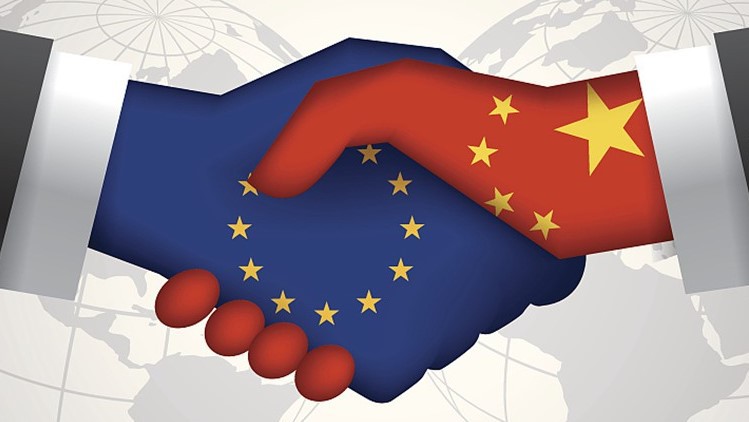The European Union and China successfully reached a consensus on a Comprehensive Agreement on Investment (CAI) at the end of 2020, signaling closer trade relations and greater multifaceted cooperation between the two regional juggernauts.
The deal has several implications for the future of the two regions and the global balance of power. After being ratified by both sides, it will be the first trade agreement ever established between the EU and China. The CAI will replace several bilateral trade deals China has with the 27 EU member states, and provide a uniform agreement for China and the EU as a whole.
The CAI strives to liberalize trade between two of the world’s most significant economies. This will grant investors in China and throughout the EU greater access to foreign markets, thereby increasing bilateral investment and boosting their economies amid COVID-19 and an eventual post-pandemic world. Additionally, the CAI also encourages cooperation in the field of sustainable development and addresses ongoing economic issues including environmental protection, labor, and the transfer of technology across borders.
Though the jury is still out, the CAI is likely to be an enduring commitment made by the EU and China. Prior to reaching the final agreement, the two sides had already spent seven years and 35 rounds of talks to thoroughly discuss every aspect of what a direct trade agreement would look like. The increasingly interconnected nature of the EU and China’s trade and financial systems explains both sides’ determination to achieve a bilateral deal.
China is currently the EU’s largest trading partner, and the EU has also been China’s largest trade partner for the last 16 years, only to be replaced by the Association of Southeast Asian Nations (ASEAN) earlier in 2020. Last year, the EU’s direct investment in the Chinese market had reached almost $118 billion, while the amount of Chinese investment in the EU topped $80 billion. Even though China has only recently achieved “superpower” status (in recent decades, that is) it has long been an economic powerhouse. Its implementation of the Belt and Road Initiative, a series of economic infrastructure and development projects throughout South, East and Central Asia, Europe, the Middle East and North Africa, and Sub-Saharan Africa, and its active role in the Regional Comprehensive Economic Partnership Agreement (RCEP), the largest international trade pact, has revealed its strong economic potential and blooming political influence.
China’s growing influence in Europe is also evidenced by European leaders’ enthusiasm toward deepening ties with the country. Both German Chancellor Angela Merkel and French President Emmanuel Macron are proponents of the CAI and visited China in 2019 on separate occasions to discuss business and trade between their countries.
The EU and China’s intertwined economies and their strong need for closer cooperation are rather evident. Yet, there are also controversies threatening the long-term endurance and resilience of the CAI. In Brussels, there are rising voices at the European Parliament that are calling attention to labor and human rights issues in China, which may present obstacles to the agreement’s ratification. European Commission officials have made clear that they will require China’s commitment to ratifying the International Labour Organization’s conventions, and will continue to follow up on the issue until this is achieved. Apart from this, the CAI is also raising questions about the balance of power on the world stage and whether the agreement will have negative implications for the transatlantic partnership between the EU and the United States.
The CAI’s progress has already raised doubts about the EU’s loyalty to the United States, and several American media outlets have reported on growing opposition to the agreement. Viewing China as a threat, some experts within U.S. media and analysts hold a rather pessimistic view toward the CAI, claiming that the Chinese government is unlikely to adhere to its commitments and break its promises. Some perceive that, in ratifying the agreement, the EU would be ignoring human rights problems in China and harming its alliance with the U.S. by cooperating with one of the country’s biggest rivals.
However, opposition from the EU’s American ally is still far from hindering the CAI’s progress, as the EU’s relationship with the United States has deteriorated due to the intense trade war started by the previous Trump administration. The EU and the United States continue to have disputes over billions of dollars worth of tariffs on automobiles and metals, digital taxes for U.S. tech companies, and airplane subsidies. Although the United States announced its intention to repair relationships with traditional allies, considering that the Biden administration has shown no commitment to ending the trade war, the transatlantic relationship remains strained. In fact, icy EU-U.S. relations may actually be propelling the CAI forward, as the EU must look to other states for economic allies.
Moreover, the agreement will provide a significant boost to European businesses in China and bring unignorable economic benefits to its member states, a needed boost amid the COVID-19 pandemic. According to the European Commission, China will provide an “unprecedented” level of access to foreign investors, as it is opening up its sectors including financial services, construction, telecommunications services, transport, environmental services and automotive. China has also promised to open up more of its manufacturing sectors to its trade partner for the first time.
This is an important accomplishment for the EU, which already has more than half of its investments in the Chinese manufacturing sector. The CAI also has incredible political significance, serving as a proclamation of the EU’s strategic autonomy and independence from the American influence. By securing the deal, the EU may be able to obtain a more advantageous position in future trade negotiations with the United States. One reason for this is that the current Phase One trade deal between the United States and China only benefits U.S. companies and potentially puts EU investors at a disadvantage in the Chinese market. The CAI’s ratification may serve to minimize the negative impact of this.
On the other side, China is optimistic in establishing closer trade relations with the EU. The CAI for China will level the playing field for its investors in Europe, and potentially enable companies to receive greater regulatory approval for investments in the European market. Additionally, the CAI could create a closer political bond between China and the EU, giving China leverage against the United States in their trade war.
However, China also understands that Europe’s slow pivot to the East is not necessarily permanent and is subject to certain conditions. In order to foster the trust and cooperation necessary to make the CAI an enduring commitment, China needs to assure the EU of its determination to protect labor and human rights. Nevertheless, China’s enthusiasm for the CAI sends a signal to the world that it is willing to open up more of its domestic market to foreign investment. It also proves that China is able to establish multilateral trade deals with Western economies and set a standard for future negotiations with other trade partners.
Though there are some factors that may hinder the ratification of the final deal, the future of the CAI and the future of EU-China relations, for now, seems bright.






